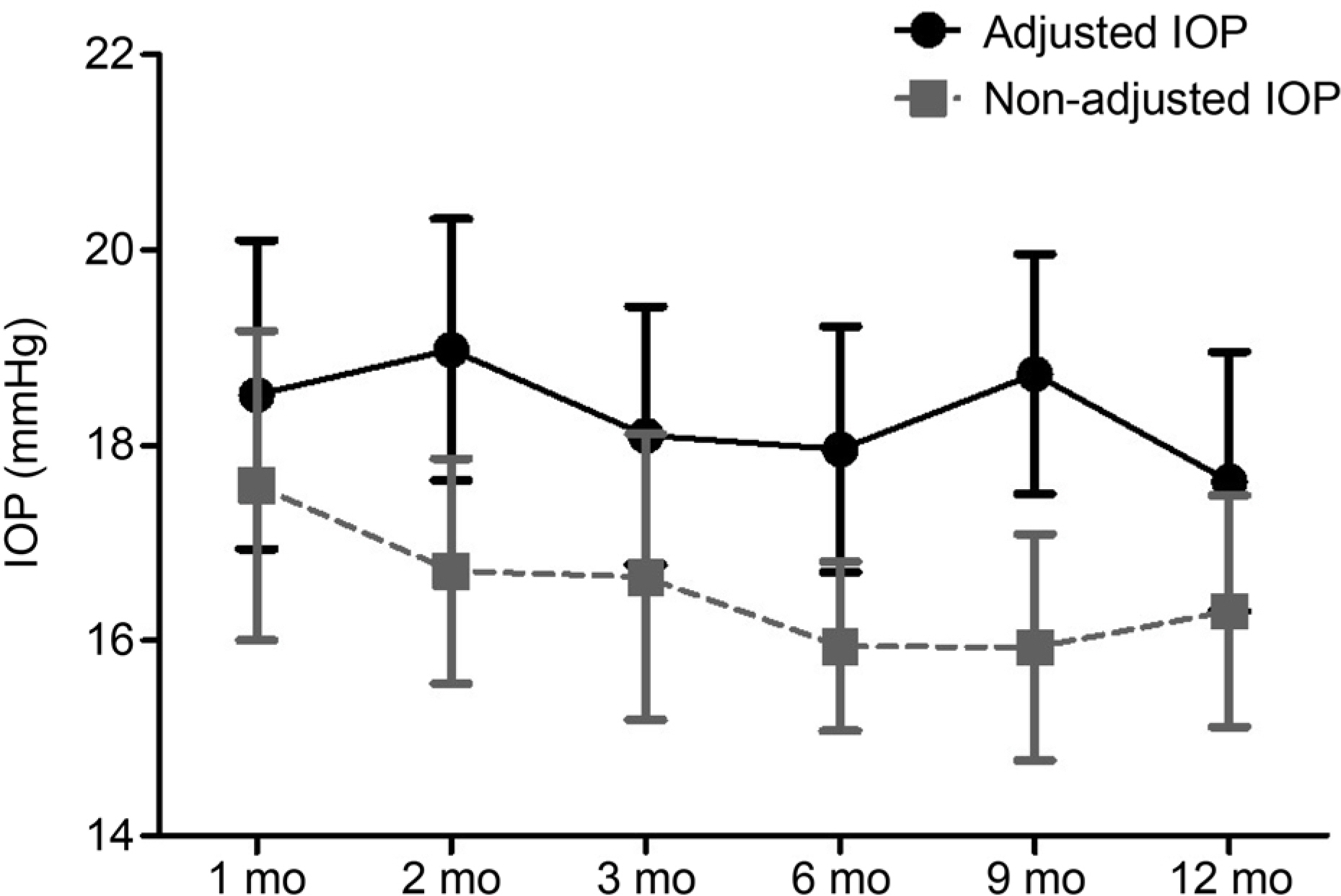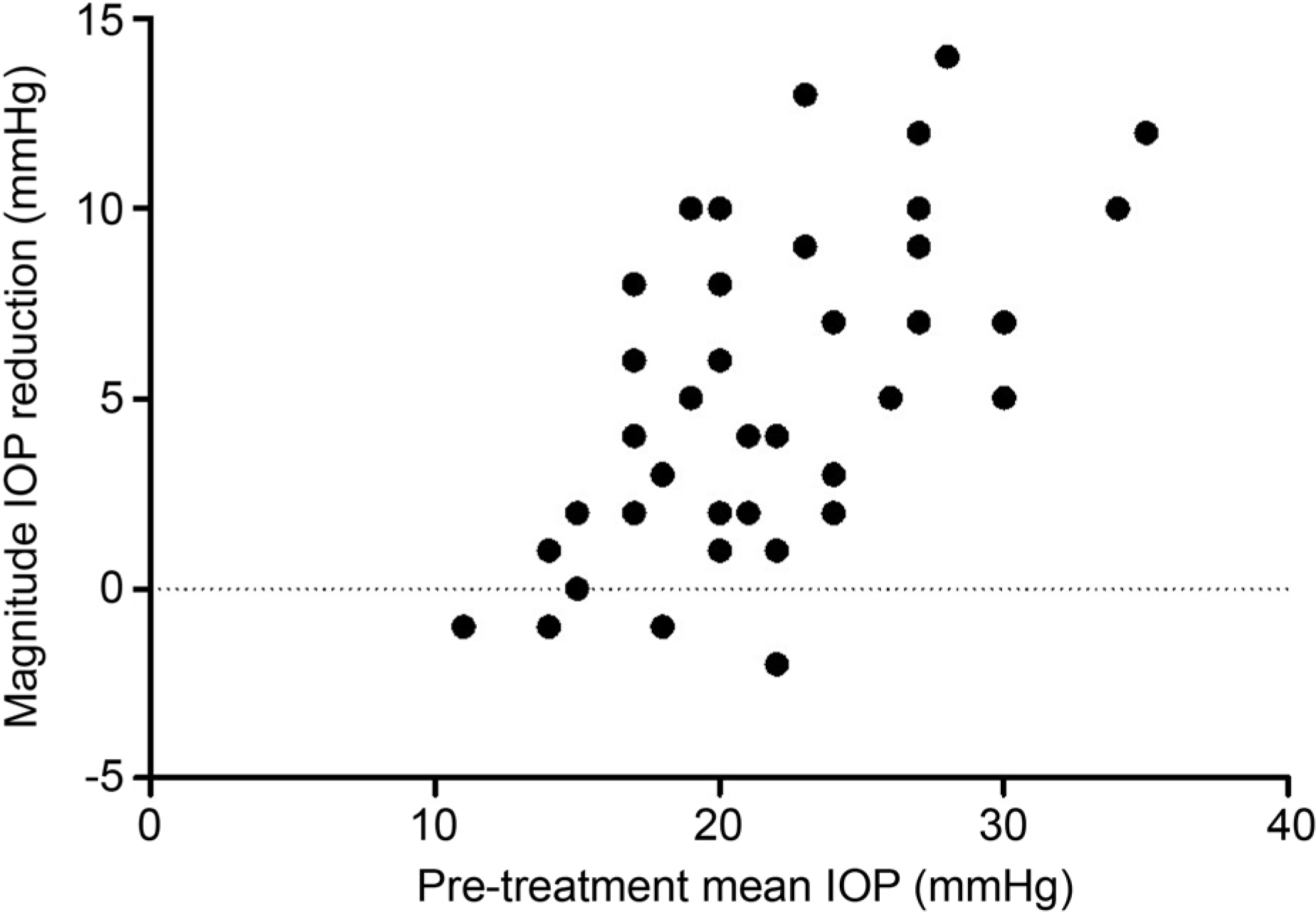J Korean Ophthalmol Soc.
2018 Dec;59(12):1166-1172. 10.3341/jkos.2018.59.12.1166.
Predictors of Success of Selective Laser Trabeculoplasty Adjusted for Intraocular Pressure Variations
- Affiliations
-
- 1Cheil Eye Hospital, Daegu, Korea. vit.s0324@gmail.com
- 2Department of Ophthalmology, Keimyung University School of Medicine, Daegu, Korea.
- KMID: 2428689
- DOI: http://doi.org/10.3341/jkos.2018.59.12.1166
Abstract
- PURPOSE
To investigate the efficacy, and identify predictors of success of selective laser trabeculoplasty (SLT) in open-angle glaucoma (OAG) patients after adjusting for intraocular pressure (IOP) changes in the untreated fellow eye.
METHODS
This retrospective chart review included 52 eyes of 52 OAG patients who underwent SLT in one eye and were followed-up for at least 1 year after the procedure. The IOP was measured before the treatment, at 1, 2, and 3 months posttreatment, and every 3 months thereafter. To account for the possible influence of IOP fluctuations on laser outcomes, post-laser IOP values of the treated eye of each patient were also analyzed, after adjusting for IOP changes in the untreated fellow eye. Success was defined as an IOP decrease ≥20% of the pretreatment IOP. The success rate was determined based on Kaplan-Meier survival analysis and factors predictive of success were analyzed using the Cox proportional hazard model.
RESULTS
The mean pretreatment IOP was 23.17 ± 6.96 mmHg. The mean IOP reduction was 5.59 ± 4.78 mmHg (29.7%) and the success rate was 65.4% at 1 year. The adjusted mean IOP reduction was 4.70 ± 4.67 mmHg (23.9%) and the adjusted success rate was 53.9%. Pretreatment IOP was associated with SLT success; the higher the pretreatment IOP, the greater the post-laser IOP reduction (p = 0.025). Age and mean deviation index did not show a significant association with SLT success (p = 0.066 and p = 0.464, respectively).
CONCLUSIONS
SLT is a safe and effective alternative method of IOP reduction in OAG patients. Herein, pretreatment IOP was the only factor significantly associated with SLT success. IOP fluctuations of the untreated eye should be considered for a better understanding of the impact of treatment.
Keyword
MeSH Terms
Figure
Reference
-
References
1. Heijl A, Leske MC, Bengtsson B, et al. reduction of intraocular pressure and glaucoma progression: results from the early manifest glaucoma trial. Arch Ophthalmol. 2002; 120:1268–79.2. Latina MA, Sibayan SA, Shin DH, et al. Q-switched 532-nm Nd:YAG laser trabeculoplasty (selective laser trabeculoplasty): a multicenter, pilot, clinical study. Ophthalmology. 1998; 105:2082–8. discussion 2089–90.3. Juzych MS, Chopra V, Banitt MR, et al. Comparison of long-term outcomes of selective laser trabeculoplasty versus argon laser abdominal in open-angle glaucoma. Ophthalmology. 2004; 111:1853–9.4. Latina MA, Gulati V. Selective laser trabeculoplasty: stimulating the meshwork to mend its ways. Int Ophthalmol Clin. 2004; 44:93–103.
Article5. McIlraith I, Strasfeld M, Colev G, Hutnik CM. Selective laser abdominal as initial and adjunctive treatment for open-angle glaucoma. J Glaucoma. 2006; 15:124–30.6. Melamed S, Ben Simon GJ, Levkovitch-Verbin H. Selective laser trabeculoplasty as primary treatment for open-angle glaucoma: a prospective, nonrandomized pilot study. Arch Ophthalmol. 2003; 121:957–60.7. Shazly TA, Smith J, Latina MA. abdominal safety and efficacy of selective laser trabeculoplasty as primary therapy for the treatment of pseudoexfoliation glaucoma compared with primary open-angle glaucoma. Clin Ophthalmol. 2010; 5:5–10.8. Medeiros FA, Weinreb RN, Zangwill LM, et al. abdominal abdominal pressure fluctuations and risk of conversion from ocular abdominal to glaucoma. Ophthalmology. 2008; 115:934–40.9. Wakabayashi Y, Higashide T, Sugiyama K. Improved prediction of fellow-eye response in one-eye trials using multiple intraocular pressure measurements. Jpn J Ophthalmol. 2011; 55:480–5.
Article10. Wilensky JT, Gieser DK, Dietsche ML, et al. Individual variability in the diurnal intraocular pressure curve. Ophthalmology. 1993; 100:940–4.
Article11. Damji KF, Bovell AM, Hodge WG, et al. Selective laser abdominal versus argon laser trabeculoplasty: results from a 1-year randomised clinical trial. Br J Ophthalmol. 2006; 90:1490–4.12. Rozsival P, Kana V, Hovorkova M. Selective laser trabeculoplasty. Cesk Slov Oftalmol. 2004; 60:267–74.13. Weinand FS, Althen F. abdominal clinical results of selective laser trabeculoplasty in the treatment of primary open angle glaucoma. Eur J Ophthalmol. 2006; 16:100–4.14. Kim JS, Lee YG, Hong YJ. Q-switched, frequency doubled Nd:YAG laser trabeculoplasty. J Korean Ophthalmol Soc. 1999; 40:2591–6.15. Kim YJ, Moon CS. One-year follow-up of laser trabeculoplasty abdominal Q-switched frequency-doubled Nd:YAG laser of 523 nm wavelength. Ophthalmic Surg Lasers. 2000; 31:394–9.16. Nagar M, Ogunyomade A, O'Brart DP, et al. A randomised, abdominal study comparing selective laser trabeculoplasty with abdominal for the control of intraocular pressure in ocular hypertension and open angle glaucoma. Br J Ophthalmol. 2005; 89:1413–7.17. Hodge WG, Damji KF, Rock W, et al. Baseline IOP predicts abdominal laser trabeculoplasty success at 1 year post-treatment: results from a randomised clinical trial. Br J Ophthalmol. 2005; 89:1157–60.18. Kramer TR, Noecker RJ. Comparison of the morphologic changes after selective laser trabeculoplasty and argon laser trabeculoplasty in human eye bank eyes. Ophthalmology. 2001; 108:773–9.
Article19. Stein JD, Challa P. Mechanisms of action and efficacy of argon abdominal trabeculoplasty and selective laser trabeculoplasty. Curr Opin Ophthalmol. 2007; 18:140–5.20. Rhodes KM, Weinstein R, Saltzmann RM, et al. Intraocular abdominal reduction in the untreated fellow eye after selective laser trabeculoplasty. Curr Med Res Opin. 2009; 25:787–96.21. Rachmiel R, Trope GE, Chipman ML, et al. Laser trabeculoplasty trends with the introduction of new medical treatments and abdominal laser trabeculoplasty. J Glaucoma. 2006; 15:306–9.22. Barkana Y, Belkin M. Selective laser trabeculoplasty. Surv Ophthalmol. 2007; 52:634–54.
Article23. Damji KF, Shah KC, Rock WJ, et al. Selective laser abdominal v argon laser trabeculoplasty: a prospective randomised clinical trial. Br J Ophthalmol. 1999; 83:718–22.24. Kano K, Kuwayama Y, Mizoue S, Ito N. Clinical results of selective laser trabeculoplasty. Nippon Ganka Gakkai Zasshi. 1999; 103:612–6.
Article25. Song J, Lee PP, Epstein DL, et al. High failure rate associated with 180 degrees selective laser trabeculoplasty. J Glaucoma. 2005; 14:400–8.
Article26. Scherer WJ. Effect of topical prostaglandin analog use on outcome following selective laser trabeculoplasty. J Ocul Pharmacol Ther. 2007; 23:503–12.
Article27. Koucheki B, Hashemi H. Selective laser trabeculoplasty in the treatment of open-angle glaucoma. J Glaucoma. 2012; 21:65–70.
Article28. Mao AJ, Pan XJ, McIlraith I, et al. Development of a prediction rule to estimate the probability of acceptable intraocular pressure reduction after selective laser trabeculoplasty in open-angle abdominal and ocular hypertension. J Glaucoma. 2008; 17:449–54.29. Martow E, Hutnik CM, Mao A. SLT and adjunctive medical abdominal: a prediction rule analysis. J Glaucoma. 2011; 20:266–70.30. Lee JW, Liu CC, Chan JCh, et al. Predictors of success in selective laser trabeculoplasty for primary open angle glaucoma in Chinese. Clin Ophthalmol. 2014; 8:1787–91.
Article
- Full Text Links
- Actions
-
Cited
- CITED
-
- Close
- Share
- Similar articles
-
- Long-Term Outcomes and Predictive Factors for Success of Selective Laser Trabeculoplasty
- Long-term Results of Selective Laser Trabeculoplasty versus Latanoprost or Dorzolamide/Timolol Fixed Combination
- Comparison of Clinical Outcomes of Argon Laser Versus Selective Laser Trabeculoplasty in POAG
- Effect of Prior Cataract Surgery on the Clinical Outcome of Selective Laser Trabeculoplasty
- The Effect of 1 % Apraclnidine on Intraocular Pressure Following Argon Laser Iridotomy and Laser Trabeculoplasty




